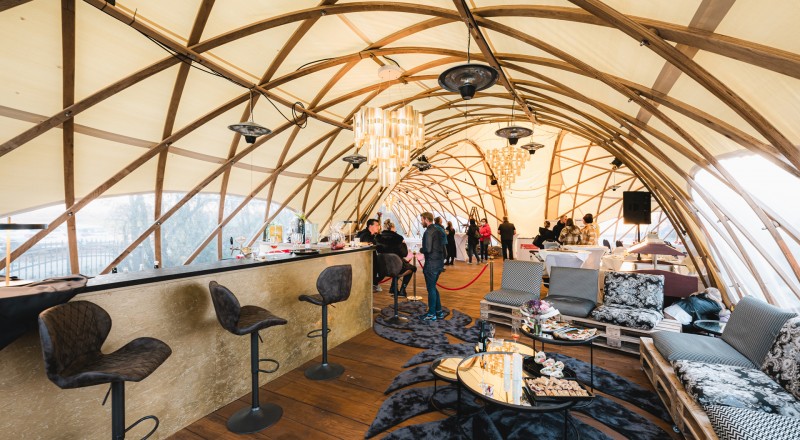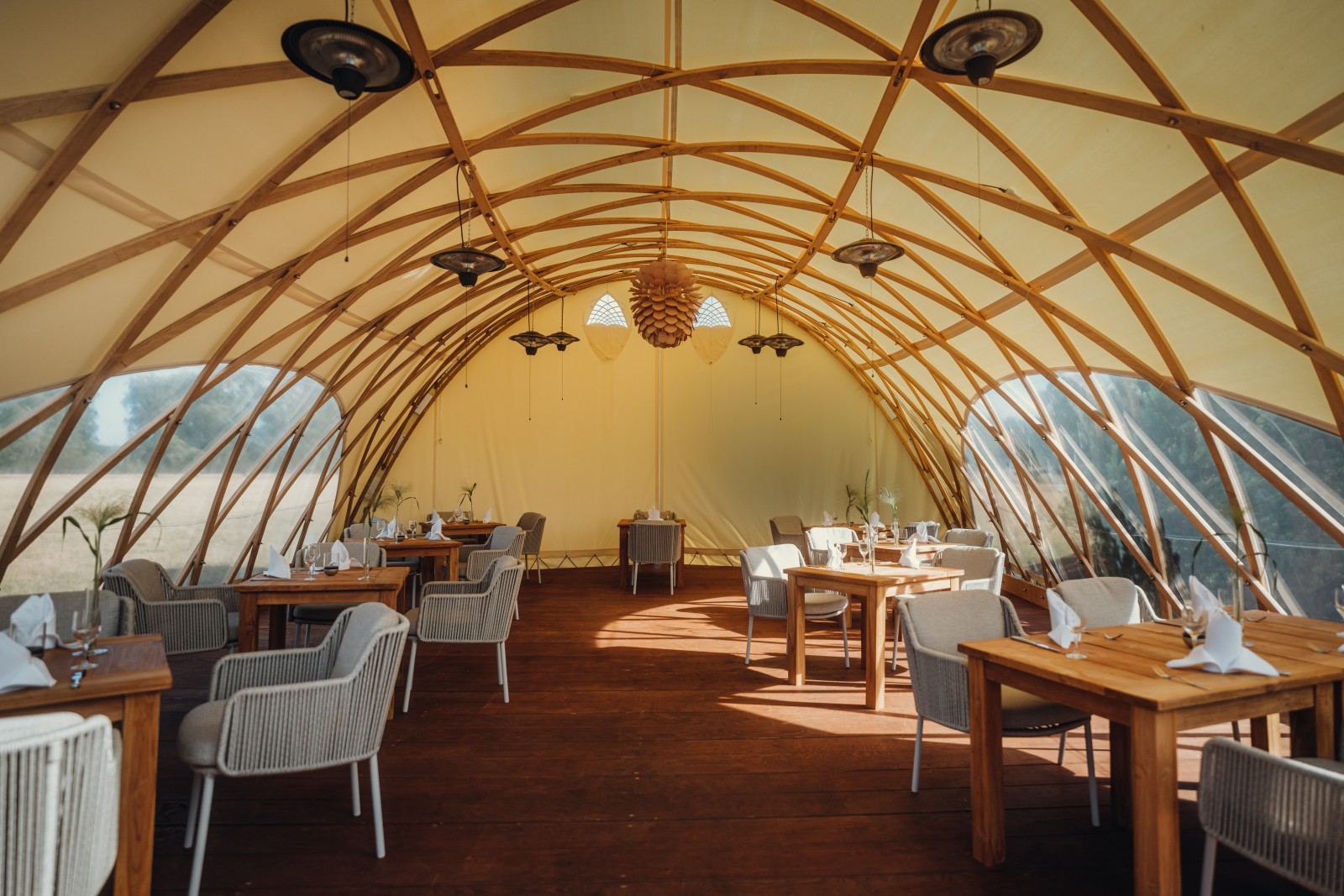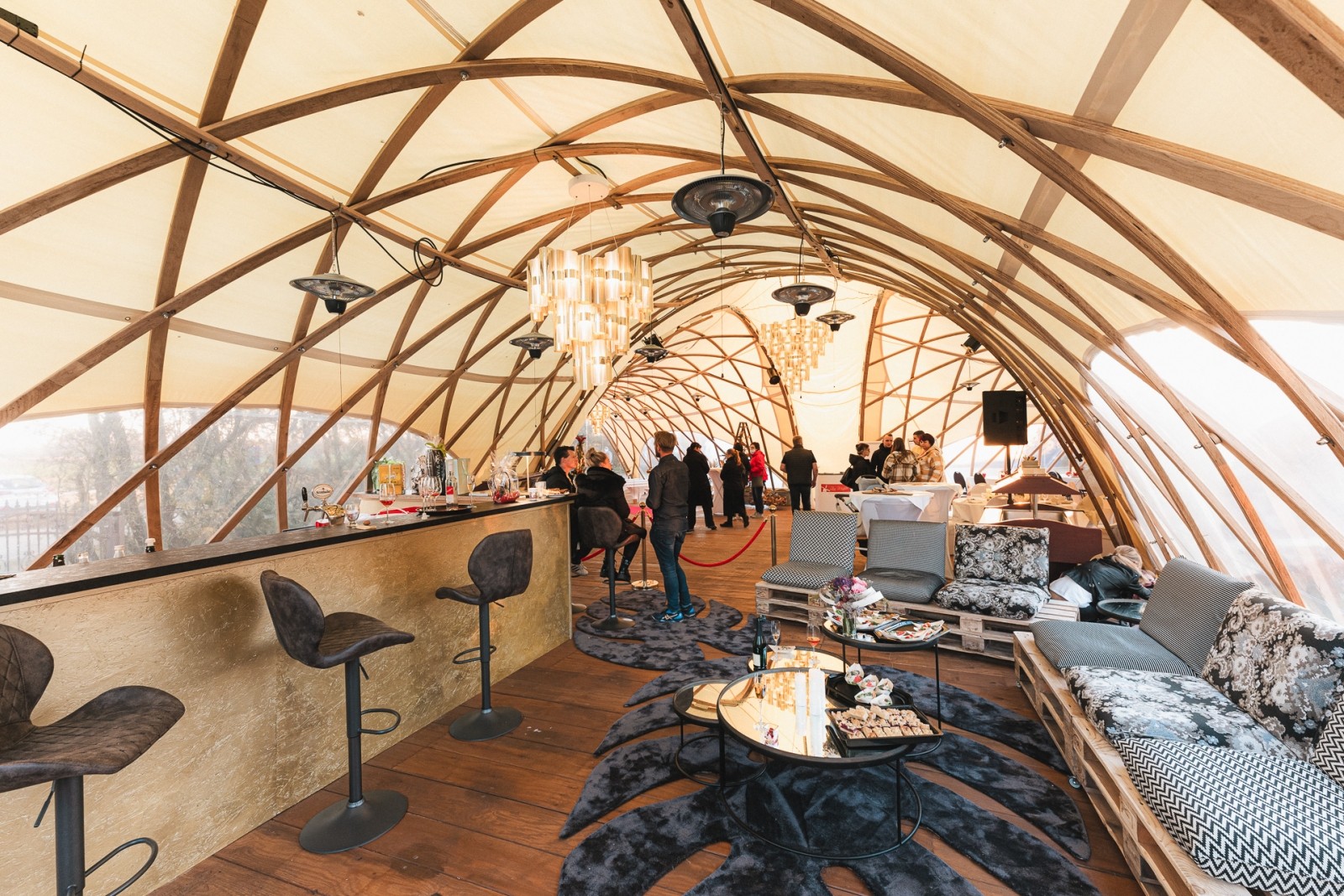Important note in advance: Extreme weather can rapidly become an unpredictable danger. Therefore, it is essential to strictly adhere to the safety instructions provided by individual manufacturers as well as any instructions issued by authorities.
Storm proof gazebo – Which pavilion withstands a storm?

A garden gazebo or pavilion is a wonderful place to enjoy nature and spend time outdoors. However, the weather can often be unpredictable, especially when it comes to strong winds and storms. Therefore, it is crucial to choose a pavilion that is sturdy and can withstand storms, without compromising its charm and functionality.
In this article, we will explore the features and qualities that make a weatherproof pavilion capable of withstanding storms. We will also take a look at the types of pavilions that are best suited for stormy conditions and examine the STROHBOID gazebo.
What makes a gazebo or pavilion storm-resistant?
A storm-proof gazebo or pavilion is characterized by a combination of specific features that ensure its robustness in extreme weather conditions. The side walls play a crucial role, providing a solid structure to withstand strong winds.
In some pavilions, the side panels are removable, and it may be advisable to remove them during storms. However, this depends on the specific product, so it's important to refer to the manufacturer's information. The waterproofing of the roof and materials is not only important for rain protection, but also for resilience against wind gusts.
Whether it's a pergola, garden house, gazebo as a terrace cover, or a classic pavilion, the design is also a key factor. A sturdy construction can withstand strong winds while maintaining an aesthetically pleasing appearance without compromising functionality
Important to know – When is it considered a "storm"?
When one speaks of a storm in Germany, it is clearly defined: According to the German Weather Service, a storm is a weather event that can cause "considerable damage and destruction."
The reason for this is the strong wind force. The Beaufort scale is often used to measure wind strength, which takes into account the average wind speed. It further distinguishes between different categories, such as Beaufort 9 (strong/severe gale, 47–54 mph), Beaufort 10 (storm/whole gale, 55–63 mph), and Beaufort 11 (violent storm, 64–72 mph).1
Ground Anchoring
The anchoring in the ground is essentially the foundation for making a gazebo storm-proof. A solid connection to the ground ensures the necessary stability. It's not only about the anchor points, but also about the type of fasteners used – some models include pegs, tension straps, or sandbags. In addition, some gazebo or pavilion types utilize a cast foundation.
The choice of suitable anchoring depends on factors such as the gazebo's location, soil type, expected wind strength, and the gazebo model itself. For instance, sandbags can be effective on hard surfaces, while pegs and tension straps are better suited for softer ground. The proper anchoring ensures that the gazebo or pavilion remains secure and stable even in strong winds.
Robust framework, sturdy sidewalls
A storm-resistant gazebo requires a robust framework and stable side walls. Materials such as powder-coated steel frame or specially treated wood for the structure are highly sought after.
The framework provides a solid structure that adds stability to the gazebo, while sidewalls made of durable fabric or similar resistant materials - ideally UV-resistant for additional sun protection - secure the interior of the gazebo. The side walls play a crucial role as they shield the gazebo from sideways winds, improving overall stability, but they also provide a surface for gusts to attack.
Therefore, it is essential to carefully follow the manufacturer's instructions to properly handle the gazebo in the event of a storm. Additionally, the weight of the gazebo itself contributes to its stability in strong winds, enhancing its standability

Weatherproof cover
The weatherproof cover is an essential element for the storm resistance of a gazebo or pavilion. It not only needs to withstand strong winds but also provide protection against rain. A gazebo or pavilion roof made of robust polycarbonate or similar waterproof materials is of great importance in this regard.
Ensuring protection against moisture is crucial to keeping the interior dry and comfortable, particularly when storm gusts are accompanied by rain. These weatherproof materials also offer a certain degree of sun and UV protection, allowing for a pleasant atmosphere in the gazebo even on sunny days.
Aerodynamic design
A streamlined design is a crucial factor that makes a gazebo resistant to storms. By intelligently shaping and surfacing the gazebo, the wind can be efficiently directed around it. This minimizes resistance and reduces the wind's target area.
Aesthetics are also important for a sleek gazebo design, not just functionality. The design can be inspired by modern design principles that prioritize both stability and aesthetics. For example, the STROHBOID gazebo's design is inspired by natural forms, making it not only storm proof up to 99 mph, but also visually appealing.
Folding gazebo, party tent or firmly anchored garden pavilion?
A storm requires robust structures, which is why firmly anchored garden gazebos or pavilions are generally more storm-resistant than folding gazebos or party tents. While folding pavilions, marquees, and party tents have their advantages in terms of flexibility and quick assembly time, firmly anchored garden pavilions are often better prepared for strong winds due to their stable construction.
Although aluminum gazebos with a fixed frame and deluxe models offer some stability, they may not be as resilient as firmly anchored pavilions. Garden tents and pop-up gazebos may be convenient, but their lightweight and quick installation make them more vulnerable to strong winds.
In the event of a storm, it is therefore often recommended to choose a firmly anchored gazebo, as this type of structure typically provides more stability and resistance to strong winds.
Important: Please follow the manufacturer's instructions
When selecting a storm-proof gazebo, it is essential to carefully consider the local weather conditions and follow the manufacturer's instructions. Each gazebo or pavilion may have specific specifications and recommendations for the maximum wind strength it can withstand.
You can usually find this information in the product descriptions or manuals provided by the manufacturer. Some manufacturers also provide clear guidance on how to anchor and set up the gazebo to ensure stability during unfavorable weather conditions.
Additionally, there may be instructions on what actions to take in case of strong winds, such as dismantling certain parts or the entire gazebo. Ignoring these instructions can put your gazebo or pavilion at risk and compromise its longevity and safety during stormy conditions
Storm proof gazebos by STROHBOID
Storm proof gazebos from STROHBOID are characterized by a well-thought-out construction and high-quality materials. The company utilizes a combination of sustainable LVL wood and innovative membranes to create a gazebo that is not only aesthetically pleasing but also capable of withstanding the challenges of strong winds.
With a robust structure made of LVL wood and a stable anchoring in the ground, the STROHBOID gazebo or pavilion can withstand strong gusts of wind. The innovative membrane provides not only wind protection but also waterproofing. Learn more – Waterproof Gazebo for Rain and Snow.
The unique combination of sustainable materials and innovative design makes STROHBOID's stormproof pavilions a reliable choice for those who value durability, aesthetics, and functionality.

¹ Modern Beaufort scale from Wikipedia: https://en.wikipedia.org/wiki/Beaufort_scale

Categories